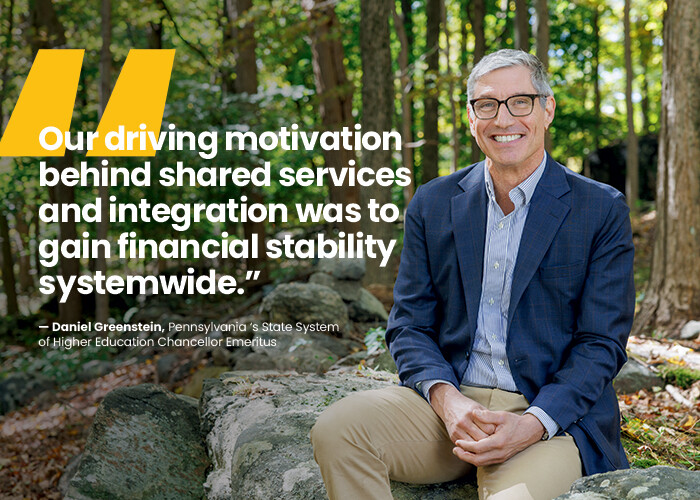When I started in 2018, we were spending way more than we took in from state and tuition-based revenue. We realized that our smaller schools were going to have to substantially compress their program arrays. But that breadth is important. Opportunities for majors, minors and degrees are important not just for students who want and need them, those communities rely on them for their next generation of everything from business to healthcare and teaching. If you’re looking at a school that once had 80 or 90 programs, and it’s on a path to contract to 30, that’s absolutely devastating for students and their communities.
Our driving motivation behind shared services and integration was to gain financial stability systemwide and sustain opportunity for all of our students. Our schools can now maintain 90 to 100 programs because they’re part of and accountable to this larger entity.
Our five-year integration plans started implementation with students admitted in fall 2022, so we’re accepting our third cohort of students this fall. We now have the baseline processes, technologies and policies established. The core is largely done. We’ve taken all of these separate ways of doing things and brought them together. We’re now determining how we work together and who we are. Culturally, we’re still evolving.
EDTECH: There are a lot of differences from campus to campus, but also from IT department to IT department. How was that aspect of the integration managed?
GREENSTEIN: On the technology side, we did a lot of things right. There was a foundational planning principle and process that happened before the board of governors voted to integrate in July 2021. We created 29 working groups, one focused on academic and student supports, one on IT, etc. They all had a specific charge with timelines and deliverables.
First, they determined what had to be in place on day one, when students show up. What needs to work on that day? We called that our critical path to day one.
We also determined our long-range measurable goals and the leading indicators that all of the schools would be looking at to see whether they were on track. We had a system-level technology group, so we had to look at both system and regional technology trajectories.
You can imagine, from a technology perspective, that a boatload of things have to be up and working on day one, starting with the registrar functions, financial aid, class enrollment, the student information system and all of the things that links into. These folks were on a fast track. It was the most professionally managed project I have ever seen. A lot of people did a lot of hard work, and they nailed it.
EDTECH: Did you have an opportunity to refresh and modernize more efficiently because you were starting almost from scratch?
GREENSTEIN: In 2020, there was a lot of one-time money that many universities and colleges poured into basic operations, and now that money is gone, you’re seeing a lot of closures throughout the country. We used some of it to stand up operations, but most of it went toward this redesign, so it was an accelerant.
We were in the fortunate position to be able to innovate and invest in IT and infrastructure. When you’re throwing all of the cards up into the air, you can design for meta outcomes, and that’s what was happening.
We were also migrating the entire system to a single, cloud-based Ellucian Banner platform, which all of our universities are now on, and that enables program sharing. Our integrated universities were the first out of the gate on that, and now they’ve used it to blend what were once three separate curricula.












